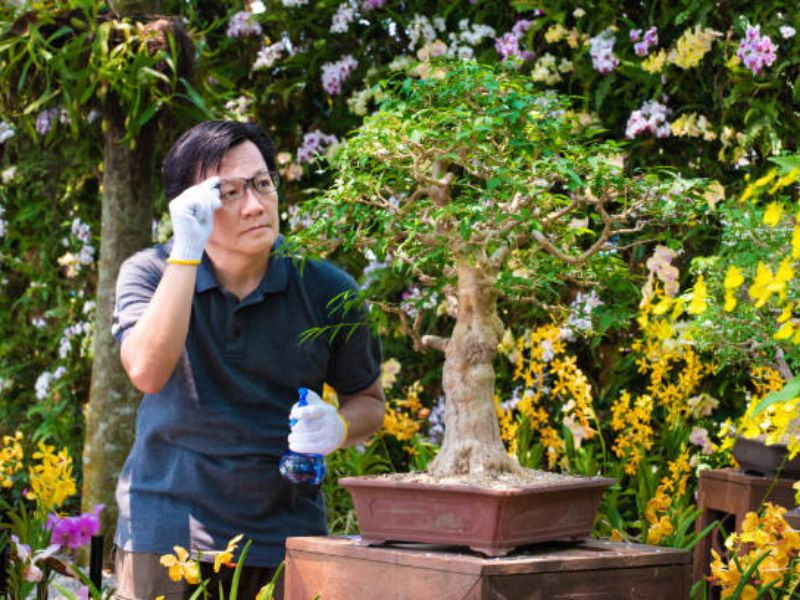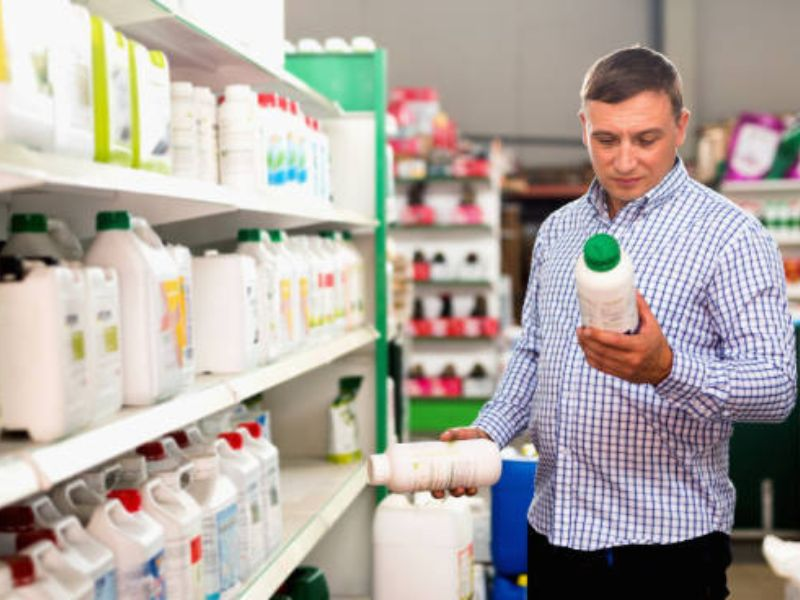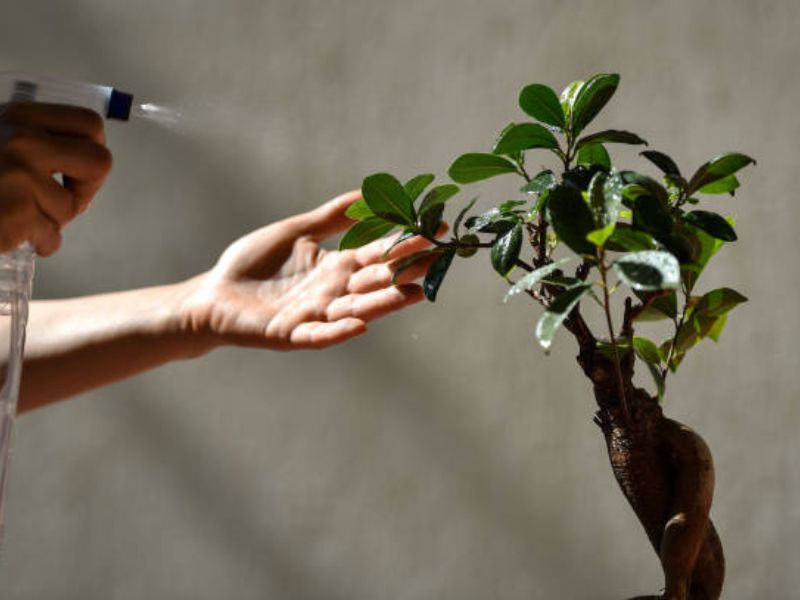Liquid bonsai fertilizer is pivotal for the thriving of these miniature trees, laying the foundation for robust health and vitality.
In the intricate world of bonsai care, nourishment is not merely a routine; it is an art that balances growth and sustenance. This method of fertilization, often preferred by enthusiasts and professionals alike, delivers a direct and controlled dose of essential nutrients to the delicate root systems of bonsai trees.
Whether tending to an ancient Pine or a blossoming Cherry, understanding and applying liquid fertilizer can make the difference between a merely surviving tree and a flourishing piece of living sculpture.
With thoughtful application, bonsai fertilizer ensures that these treasured plants receive the precise nutrition they need to showcase their natural beauty and to continue growing in harmony with their environment.
Understanding Bonsai Nutrition

Bonsai plants, much like their full-sized counterparts, require a delicate balance of vital nutrients to thrive—namely nitrogen, phosphorus, and potassium, alongside a suite of micronutrients.
These essentials support everything from the development of luscious foliage and strong roots to the formation of vibrant flowers and fruits.
When it comes to delivering these plant nutrients, the choice between organic fertilizers and chemical options is significant. Organic fertilizers, derived from natural sources such as fish emulsion or composted materials, release nutrients slowly and improve soil structure, thus fostering a beneficial environment for root development and microbial activity.
Chemical fertilizers, on the other hand, may provide a quicker nutrient boost but can lead to salt build-up in the soil, which can be detrimental to the delicate root systems of bonsai trees.
The soil health for bonsai is paramount, and organic matter is the cornerstone of a vibrant substrate. It acts as a sponge, holding moisture and nutrients in place until the bonsai roots require them.
Moreover, organic matter provides a habitat for beneficial microorganisms that break down nutrients into forms more accessible to the plant.
By enhancing the soil with organic matter, bonsai enthusiasts can ensure their trees receive a steady stream of nutrients, leading to a more robust and resilient plant. Thus, when considering plant food for bonsai, one must weigh the long-term benefits of organic nutrients against the immediate yet fleeting perks of synthetic options, always keeping the health of the bonsai’s micro-ecosystem in mind.
Benefits Of Liquid Fertilizers For Bonsai
Liquid fertilizers offer a trove of advantages for both outdoor and indoor bonsai trees, making them a popular choice among bonsai cultivators. For indoor trees, which often live in less dynamic environments than their outdoor counterparts, the precise application of liquid fertilizers can compensate for the lack of natural nutrient sources, ensuring that these miniature ecosystems receive all the necessary nourishment without overwhelming them.
Outdoor bonsai benefit similarly, as the liquid form allows for nutrients to be evenly dispersed throughout the soil, reaching the roots directly and avoiding the common pitfalls of uneven granular fertilizer distribution.
The true merit of bonsai liquid nutrient lies in its capacity to promote healthy growth through consistent nutrient delivery. Being in a liquid state, these fertilizers ensure that nutrients are immediately available to the plant, which is crucial during the peak growing seasons when bonsai trees are most actively developing.
This availability also means that the absorption of nutrients can be controlled and monitored, allowing for adjustments in feeding to meet the specific needs of the bonsai at different stages of growth or during various seasons.
Moreover, the uniform distribution minimizes the risk of nutrient ‘hotspots’ that can burn the roots, making liquid fertilizers a safer choice for the sensitive root systems of bonsai trees.
Selecting The Right Liquid Bonsai Fertilizer
Choosing the right bonsai liquid nutrient requires an understanding of the specific needs of your bonsai tree and the various formulations available. The key factors to consider include the N-P-K ratio—nitrogen (N), phosphorus (P), and potassium (K)—which should align with your bonsai’s growing stage.

Seedlings and young trees, for instance, generally require a higher nitrogen content to promote foliage growth, whereas mature trees may benefit from a lower nitrogen and higher phosphorus mix to encourage flowering and fruiting.
When focusing on organic nutrients, opt for organic fertilizer options that consist of natural plant foods like seaweed extracts or fish emulsions. These not only feed the bonsai but also contribute organic matter to the soil. Organic fertilizers support a gradual growth pattern, which is crucial for bonsai that need time to sculpt their form and structure.
The question of how much fertilizer to use is pivotal; too little, and the bonsai lacks nutrients—too much, and you risk fertilizer burn or excessive growth.
In evaluating different bonsai nutrient solutions, the origin and makeup of these products are key. Synthetic fertilizers might promise rapid results but can compromise long-term soil health. On the flip side, consistent use of organic liquid fertilizers can boost soil vitality over time, creating a nurturing environment for the bonsai’s root system.
Customizing Nutrients For Bonsai Health
Some fertilizers are formulated with micronutrients like calcium, magnesium, and sulfur, which are essential for the overall health of the bonsai. Products may also vary in concentration, with some requiring dilution before application—this can be an advantage as it allows for customization of the nutrient mix based on the bonsai’s current needs.
Ultimately, the right bonsai liquid nutrient will be one that provides a balanced diet of essential nutrients while supporting the overall health of the soil and the tree. It will be specific to the plant’s needs, easy to apply, and formulated to enhance both growth and aesthetic quality.
It’s wise to research and even consult with bonsai experts or experienced growers when selecting a fertilizer, as the right choice can lead to a visibly healthier and more beautiful bonsai.
How To Apply Liquid Fertilizer To Bonsai Trees
Applying liquid bonsai fertilizer is a nuanced process that, when executed properly, promotes vibrant growth and sustains the plant’s miniature ecosystem.
Here is an updated, detailed step-by-step guide on how to do this effectively:
Preparation
- Begin by shaking the liquid fertilizer container to ensure that all the nutrients are well mixed.
- Dilute the fertilizer to half strength, if recommended, to prevent overfeeding. This usually means mixing the fertilizer with an equal amount of water, but follows the specific product’s guidelines.
Pre-watering
- Water your bonsai tree thoroughly prior to fertilizing to moisten the soil. This helps prevent root burn and ensures that the fertilizer will spread evenly throughout the soil.
Timing
- Apply fertilizer when the tree is in its active growth phase, typically in the morning or late afternoon to avoid the heat of midday.
Application Technique
- Pour the diluted liquid fertilizer evenly over the soil surface, taking care not to splash the leaves or the trunk to avoid burning the plant.
- Ensure the fertilizer reaches all parts of the soil, ideally using a watering can with a long spout for precision.
Frequency
- Fertilize every two weeks during the growing season, which is spring through summer for most bonsai species.
- Observe your bonsai’s reaction to determine if adjustments are needed—less frequent applications may be required for slower-growing species or trees that show signs of over-fertilization.
Seasonal Adjustments
- As growth slows in the autumn, reduce the frequency of fertilization and consider switching to a formula with a lower nitrogen content to prepare the tree for winter.
- During winter months, when most bonsai enter a period of dormancy, reduce fertilization to once a month or cease altogether, depending on the species and climate.
Post-Fertilization Care
- After fertilizing, keep an eye on your bonsai for any signs of distress, such as yellowing leaves or stunted growth, which could indicate over-fertilization.
- If symptoms of over-fertilization occur, flush the soil with clean water to remove excess nutrients and adjust future applications accordingly.
Monitoring Plant Health
- Continuously monitor your bonsai for signs of nutrient deficiency or excess. Leaves, growth patterns, and overall vigor are good indicators of the tree’s health.
- Adjust the fertilization schedule and strength based on these observations to maintain a balanced nutrient environment for your bonsai.
By following these steps, you can ensure that your bonsai receives the right amount of nutrition to support its health and aesthetic qualities without the risks associated with over or under-fertilization.
DIY Organic Liquid Fertilizer For Bonsai
Creating your own organic liquid fertilizer is a rewarding and sustainable way to nourish your bonsai trees. By doing so, you not only tailor the nutrient mix to the specific needs of your plants but also engage in an eco-friendly practice that reduces reliance on store-bought products.
Here’s a straightforward guide to making and using DIY organic liquid fertilizer for your bonsai:
Composting
Start by creating a compost tea, which is a rich, nutrient-filled solution made from mature compost. Steep the compost in water for several days, allowing the soluble nutrients to infuse into the liquid.
Worm Castings
Worm tea, made from worm castings, is another excellent source of organic nutrients. Like compost tea, it’s created by soaking worm castings in water. This tea is gentle on plants and full of beneficial microbes.
Seaweed And Fish Emulsions
Seaweed extract is rich in trace elements, while fish emulsion provides a balanced N-P-K ratio. Both are excellent for promoting healthy growth and can be mixed with your compost or worm tea for an added nutrient boost.
Application
Apply your DIY liquid fertilizer just as you would a store-bought one. Dilute if necessary, and apply during the bonsai’s active growing period for the best results.
Benefits
Using DIY organic fertilizers ensures that your bonsai receives a broad spectrum of nutrients in a form that’s easy for the roots to absorb. These fertilizers are generally lower in salts than synthetic ones, reducing the risk of root burn. They also improve soil health by adding organic matter and beneficial microorganisms that promote root development and improve nutrient uptake.
Common Mistakes And Troubleshooting in Bonsai Fertilization

Navigating the fertilization of bonsai trees can be a delicate endeavor. A misstep in this process can lead to significant setbacks in the health of these miniature trees.
Let’s delve into some common fertilization errors, their consequences, and how to remedy them.
- Over-Fertilization
A common misconception is that more fertilizer will result in more growth, but this is not the case with bonsai. Over-fertilization can lead to salt build-up in the soil, causing root burn and an unhealthy appearance. Symptoms include brown, crispy leaf edges, and stunted growth.
- Under-Fertilization
Conversely, under-fertilization deprives your bonsai of the essential nutrients needed for growth, leading to weak, yellow leaves, and a general lack of vigor. This condition makes your bonsai more susceptible to disease and insect infestations.
- Recognizing Nutrient Deficiencies
Learning to read the signs of nutrient deficiencies is crucial. For example, nitrogen deficiency often presents as yellowing leaves, phosphorus deficiency can result in stunted growth or dark, dull leaves, and potassium deficiency might cause leaf edges to appear burnt.
Troubleshooting Steps:
- If over-fertilization is suspected, stop all fertilization immediately and water thoroughly several times to help flush out excess nutrients.
- For under-fertilized bonsai, introduce a balanced, half-strength liquid bonsai fertilizer and monitor the tree’s response, adjusting as needed.
- When faced with specific nutrient deficiencies, consider a targeted fertilizer to address the lacking nutrient, always at half-strength to avoid further issues.
Preventive Measures
A regular, balanced fertilization routine, tailored to the specific needs of your bonsai species and its growth stage, can prevent most issues. Also, using organic fertilizers can help minimize the risk of damage since they release nutrients more slowly and are less likely to lead to salt accumulation.
Grow With Bonsai Care!
Embark on a journey to elevate your bonsai’s health and vitality with the practices outlined in this guide. Embrace the art of using liquid bonsai fertilizer, and you’ll soon witness the remarkable difference it makes in your bonsai’s growth and vigor.
Let the tips and techniques become a natural part of your bonsai care routine, and you’ll not only nurture your trees but also deepen your connection with these living sculptures.
Discover more bonsai care essentials in our Leaves and Soul Store, your one-stop destination for all your bonsai needs.
But don’t let your exploration stop here. Dive deeper into the world of bonsai; there are vast resources available—from books and online forums to local clubs and workshops. Each offers a wealth of knowledge and community support to help you refine your skills and solve even the most perplexing bonsai puzzles.
We invite you to share your progress and insights. Join the conversation with fellow bonsai enthusiasts, exchange stories of success and challenge, and grow alongside a global community dedicated to the art of bonsai. Your experiences contribute to the collective wisdom that helps all bonsai lovers, from the novices to the seasoned masters, in cultivating beauty and harmony through these magnificent miniature trees.





0 Comments